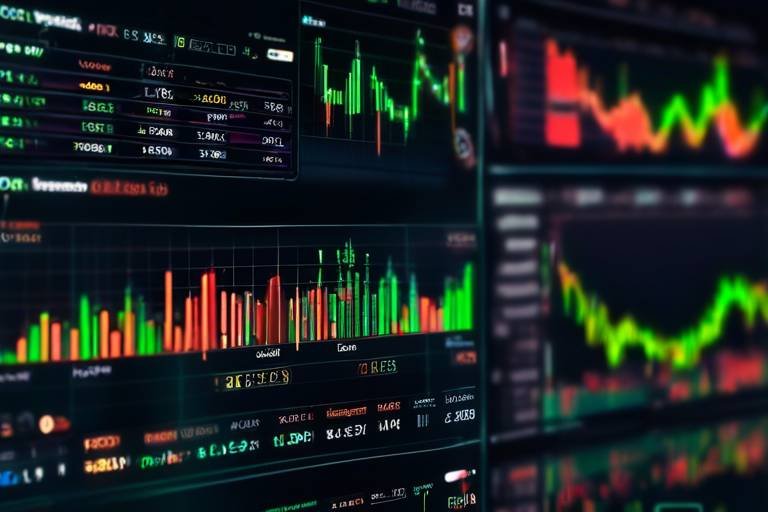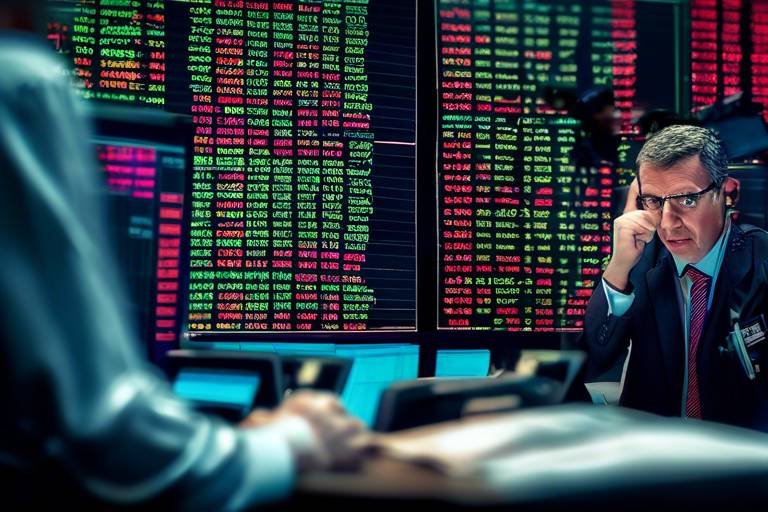How to Spot Fakeouts in Cryptocurrency Trading
In the fast-paced world of cryptocurrency trading, spotting fakeouts can mean the difference between a profitable trade and a costly mistake. Fakeouts are deceptive price movements that can mislead traders into making poor decisions. Imagine you're on a roller coaster, and just when you think you're headed for a thrilling drop, the ride unexpectedly levels out. That's what a fakeout feels like in trading—it's an emotional roller coaster that can leave you feeling dizzy and confused.
To navigate this volatile landscape, it's essential to arm yourself with knowledge and strategies that help you identify these fakeouts before they catch you off guard. By understanding the mechanics behind fakeouts and utilizing various indicators, you can enhance your trading strategies and make more informed decisions. This article aims to provide you with insights into recognizing fakeouts, the common indicators that signal them, and effective strategies to avoid falling for these traps.
So, what exactly are fakeouts? In the simplest terms, they occur when the price of a cryptocurrency breaks through a significant support or resistance level, only to reverse direction shortly after. This sudden change can leave traders confused and often results in losses. Recognizing these patterns is crucial for effective trading, as they can happen in any market condition and can be influenced by various factors, such as news events or market sentiment.
Imagine you're waiting for a bus, and suddenly, a car speeds past you, making you think it's your ride. Just as you step forward, the car swerves, and you realize it was just a mirage. Similarly, in trading, a fakeout can lure you into making a move that seems promising but quickly fades away. Understanding the psychology behind these movements can help you stay one step ahead and avoid emotional trading decisions.
Several technical indicators can signal potential fakeouts. By familiarizing yourself with these indicators, you can anticipate market movements more effectively. Here are some key indicators to keep an eye on:
- Volume Analysis: Analyzing trading volume during price movements can reveal the strength of a breakout. If a breakout occurs with low volume, it often indicates a potential fakeout.
- Candlestick Patterns: Certain candlestick formations, like pin bars or engulfing patterns, can suggest reversals. Recognizing these patterns can help you identify possible fakeouts.
- Moving Averages: Moving averages provide insight into price trends. A sudden price movement that diverges from the moving average may indicate a potential fakeout.
When analyzing volume, consider this: if a cryptocurrency breaks a resistance level but the trading volume is significantly lower than average, it’s like a party with no guests. The hype might be there, but the excitement is missing. Low volume during a breakout often indicates a lack of conviction in the move, which could lead to a quick reversal. Always keep an eye on volume trends; they can be your best friend in spotting fakeouts.
Candlestick patterns are like the language of the market. They tell a story about price action. Certain formations, such as pin bars or engulfing patterns, can serve as red flags for potential fakeouts. For instance, a pin bar at a resistance level might suggest that buyers are losing momentum, signaling a possible reversal. Learning to read these patterns can give you a significant edge in predicting market movements.
Moving averages act as a smooth line that helps you see the overall direction of the market. However, when the price suddenly moves away from the moving average, it's like a ship drifting off course. This divergence can be a warning sign of a fakeout. If the price moves sharply above or below the moving average without a solid foundation, it may be a temporary spike rather than a sustainable trend.
Understanding market sentiment is crucial in the world of cryptocurrency. News articles, social media chatter, and public sentiment can influence price movements dramatically. A sudden shift in sentiment—whether positive or negative—can precede a fakeout. For example, if a negative news story breaks and prices start to drop, a quick reversal back up might catch traders off guard. Keeping your finger on the pulse of market sentiment will help you anticipate these shifts and avoid being swept away by the tide.
Now that you know how to spot fakeouts, let's discuss some strategies to help you avoid them. Implementing specific trading strategies can mitigate the risk of falling for fakeouts, ensuring more reliable trading decisions.
One of the most effective ways to protect yourself from fakeouts is by placing stop-loss orders. These orders act as a safety net, automatically selling your position if the price falls below a certain level. Think of it as a seatbelt in your trading journey—while it won't prevent accidents, it will certainly minimize the damage if things go wrong.
Analyzing price movements across different time frames can provide a more comprehensive view of market trends. By looking at both short-term and long-term charts, you can spot potential fakeouts more effectively. It's like using a pair of binoculars while hiking; they help you see the path ahead more clearly, allowing you to navigate potential pitfalls.
Q: What is a fakeout in cryptocurrency trading?
A: A fakeout occurs when the price of a cryptocurrency breaks through a support or resistance level but quickly reverses direction, misleading traders.
Q: How can I identify a fakeout?
A: Look for low trading volume during a breakout, certain candlestick patterns, and divergence from moving averages as potential indicators of a fakeout.
Q: What strategies can I use to avoid fakeouts?
A: Setting stop-loss orders and analyzing multiple time frames are effective strategies to mitigate the risk of falling for fakeouts.

Understanding Fakeouts
In the volatile world of cryptocurrency trading, fakeouts can be a trader's worst nightmare. Imagine you're about to make a significant move, and suddenly, the price breaks through a key support or resistance level. Your heart races, and you think, “This is it! The moment I've been waiting for!” But just as quickly, the price reverses, leaving you with a sinking feeling in your stomach. This scenario is all too common and highlights the importance of understanding what fakeouts are and how they can impact your trading strategy.
A fakeout occurs when the price of a cryptocurrency temporarily breaks through a significant price level, only to reverse direction shortly after. These deceptive movements can mislead traders into making impulsive decisions, often resulting in losses. Recognizing the signs of a fakeout is crucial for anyone looking to navigate the choppy waters of crypto trading effectively.
To better understand fakeouts, it's essential to grasp the underlying psychology of the market. When a price breaks through a resistance level, it can create a sense of excitement and FOMO (fear of missing out) among traders. Many rush in, believing that the price will continue to rise. However, if the breakout lacks strong volume or is not supported by solid fundamentals, it may quickly reverse, leaving those traders in the dust.
Moreover, fakeouts can occur in both bullish and bearish markets. In a bullish fakeout, the price breaks above resistance only to fall back below it, while in a bearish fakeout, the price dips below support before reversing back up. Understanding these patterns can help you develop a more nuanced view of market movements.
Here are a few key points to remember about fakeouts:
- Volume Matters: Always analyze trading volume when observing price movements. A breakout with low volume is often a red flag.
- Market Sentiment: Pay attention to external factors such as news and social media. Sudden shifts in sentiment can precede fakeouts.
- Technical Indicators: Utilize technical analysis tools to identify potential fakeouts and confirm breakout legitimacy.
By keeping these factors in mind, you can enhance your ability to spot fakeouts and make more informed trading decisions. Remember, it's not just about the numbers on the chart; it's about understanding the market's behavior and psychology. With practice and vigilance, you can navigate the complexities of cryptocurrency trading and avoid the pitfalls of fakeouts.

Common Indicators of Fakeouts
When diving into the world of cryptocurrency trading, understanding the is essential for any trader looking to navigate the turbulent waters of market volatility. Fakeouts can be deceptive, often luring traders into a false sense of security, only to reverse direction and cause significant losses. So, how can you spot these tricky patterns? Let’s explore some of the most reliable indicators that can help you identify potential fakeouts before they happen.
One of the first indicators to consider is volume analysis. It’s like the heartbeat of the market; when you see a sudden spike in volume during a breakout, it often signifies a strong move. Conversely, if the volume is low while the price is breaking through a resistance level, it might be a red flag. Low volume suggests that there isn't enough buying interest to sustain the momentum, which could lead to a quick reversal. So, always keep an eye on the volume when analyzing price movements.
Let’s dive deeper into volume analysis. Imagine you’re at a concert; if the crowd is roaring and singing along, you know the performance is a hit. The same applies to trading. If a cryptocurrency breaks out and the volume is high, it’s like the crowd cheering for the performer. However, if the price surges with little enthusiasm (low volume), it’s akin to a solo artist singing to an empty room. This discrepancy can signal a potential fakeout, alerting savvy traders to tread carefully.
Next up are candlestick patterns. These little graphical representations of price movements can tell you a story. Certain formations like pin bars or engulfing patterns can hint at reversals. For instance, if you see a pin bar forming at a resistance level, it might indicate that buyers are losing momentum. Recognizing these patterns can give you a heads-up on possible fakeouts. Think of candlestick patterns as the language of the market; learning to interpret them can be the key to your trading success.
Moving averages are another crucial tool in your trading arsenal. They smooth out price data to help you identify trends over a specific period. A sudden price movement that diverges significantly from the moving average can be a sign of a fakeout. For example, if the price shoots up but the moving average remains flat, it could indicate that the rally lacks strength and might reverse shortly. It’s like trying to run uphill against a strong wind; you might make it for a bit, but eventually, you’ll feel the resistance pulling you back down.
Finally, let’s not forget about market sentiment. The crypto market is heavily influenced by news and social media buzz. If you notice a sudden shift in sentiment—like a popular influencer tweeting about a coin—it can create a flurry of activity. However, this excitement can sometimes lead to fakeouts. When the hype dies down, the price may plummet, leaving unsuspecting traders in the dust. Staying attuned to market sentiment can provide valuable context for price movements and help you avoid falling into the fakeout trap.
In conclusion, being aware of these common indicators—volume analysis, candlestick patterns, moving averages, and market sentiment—can significantly enhance your ability to spot fakeouts. By incorporating these tools into your trading strategy, you’ll be better equipped to navigate the unpredictable waters of cryptocurrency trading.
- What is a fakeout in cryptocurrency trading? A fakeout occurs when the price breaks through a support or resistance level but quickly reverses, misleading traders.
- How can I identify a fakeout? Look for low trading volume during breakouts, specific candlestick patterns, divergence from moving averages, and sudden shifts in market sentiment.
- What strategies can I use to avoid fakeouts? Implementing stop-loss orders and analyzing multiple time frames can help mitigate the risk of falling for fakeouts.

Volume Analysis
When diving into the world of cryptocurrency trading, one of the most crucial aspects to consider is . This refers to the study of the number of coins traded over a specific period, and it can provide invaluable insights into the strength of price movements. Think of trading volume as the heartbeat of the market; a strong, steady pulse indicates a healthy trend, while a weak pulse may signal something more concerning—like a potential fakeout.
Imagine you're at a concert. The crowd's energy is palpable when everyone is singing along, right? That's what high trading volume feels like in the crypto market. Conversely, if only a few people are clapping sporadically, you start to wonder if the band is losing its touch. Similarly, when a cryptocurrency breaks through a resistance level but does so with low trading volume, it's like that concert where enthusiasm is lacking. It raises a red flag that the breakout might not be genuine and could quickly reverse.
To further illustrate this, consider the following table that outlines different scenarios of price movements and their corresponding volume levels:
| Price Movement | Volume Level | Implication |
|---|---|---|
| Breakout above resistance | High | Strong trend likely to continue |
| Breakout above resistance | Low | Possible fakeout; trend may reverse |
| Price drop below support | High | Bearish trend likely to continue |
| Price drop below support | Low | Potential fakeout; price may rebound |
By keeping an eye on volume during significant price movements, traders can better gauge whether a breakout is legitimate or if it's just a fleeting moment. For instance, if a cryptocurrency surges past a resistance level but the volume remains low, it’s wise to exercise caution. This could be a signal to hold off on entering a position until more convincing evidence of a sustained trend emerges.
Additionally, it’s essential to consider the context of the volume. Was there a recent news event that might have sparked interest in the cryptocurrency? Was there a significant social media buzz? Understanding the background can help traders interpret volume trends more effectively. For example, a sudden spike in volume due to a major partnership announcement can be a strong indicator that the price movement is backed by genuine interest, as opposed to a mere speculative rush.
In conclusion, volume analysis is a vital tool in the arsenal of any cryptocurrency trader. By learning to read the volume signals, you can better navigate the often-turbulent waters of crypto trading and avoid falling victim to fakeouts. So, the next time you see a price breakout, take a moment to check the volume—your trading strategy will thank you for it!
Frequently Asked Questions
- What is a fakeout in cryptocurrency trading? A fakeout occurs when the price of a cryptocurrency breaks a support or resistance level but quickly reverses direction, misleading traders.
- How can I identify a potential fakeout? Look for low trading volume during significant price movements, unusual candlestick patterns, and divergence from moving averages.
- Why is volume important in trading? Volume indicates the strength of a price movement; high volume suggests a strong trend, while low volume may indicate a lack of conviction in the movement.

Candlestick Patterns
Candlestick patterns are like the secret language of the market; they whisper hints about potential price movements. When you're trading cryptocurrencies, understanding these patterns can be your compass, guiding you through the stormy seas of market volatility. Just imagine each candlestick as a little storybook, telling you about the battle between buyers and sellers over a specific time frame. The shape and color of these candlesticks can reveal whether the bulls or bears are winning, and recognizing these formations can significantly enhance your trading strategy.
Some of the most powerful candlestick patterns to watch for include pin bars and engulfing patterns. A pin bar, for instance, typically has a long wick and a small body, indicating that the price rejected a certain level and may be reversing direction. This pattern often signals that the market is losing momentum in the direction of the previous trend. On the other hand, an engulfing pattern occurs when a small candlestick is followed by a larger one that completely engulfs it. This shift can indicate a strong reversal, suggesting that the market sentiment has changed dramatically.
To help you visualize these patterns, here’s a simple table summarizing some key candlestick formations:
| Pattern | Description | Indicates |
|---|---|---|
| Pin Bar | Long wick with a small body | Potential reversal |
| Engulfing Pattern | Small candle followed by a larger one that engulfs it | Strong reversal signal |
| Doji | Small body with long wicks | Indecision in the market |
| Hammer | Small body at the top with a long lower wick | Possible bullish reversal |
| Shooting Star | Small body at the bottom with a long upper wick | Possible bearish reversal |
By keeping an eye on these patterns, you can gain invaluable insights into market sentiment and potential price reversals. However, it's essential to combine candlestick analysis with other indicators and market context. After all, these patterns are not foolproof; they are simply tools in your trading toolbox. So, the next time you're analyzing a chart, take a moment to look for these candlestick formations. They might just be the key to unlocking your trading success!
- What are candlestick patterns? Candlestick patterns are formations created by the price movements of a cryptocurrency over a specific time period, indicating potential market reversals or continuations.
- How can I use candlestick patterns in trading? Traders use candlestick patterns to identify potential entry and exit points by looking for signs of market sentiment shifts.
- Are candlestick patterns reliable? While they can provide valuable insights, candlestick patterns should be used in conjunction with other indicators for more reliable trading decisions.

Moving Averages
When it comes to understanding price trends in cryptocurrency trading, are like that trusty compass you take on a journey. They help you navigate through the tumultuous waters of market volatility, providing a clearer picture of where the price has been and where it might be headed. Essentially, a moving average smooths out price data by creating a constantly updated average price. This can be particularly useful when trying to spot potential fakeouts, as it helps traders discern the overall trend rather than getting caught up in momentary fluctuations.
There are different types of moving averages, each serving a unique purpose. The most common types are the Simple Moving Average (SMA) and the Exponential Moving Average (EMA). The SMA calculates the average price over a specific period, giving equal weight to all prices in that period. On the other hand, the EMA gives more weight to recent prices, making it more responsive to new information. This responsiveness can be crucial in identifying fakeouts, as sudden price movements that diverge from the moving average can signal a potential reversal.
For instance, if the price of a cryptocurrency suddenly spikes above its moving average but quickly retreats back below it, this could be a strong indicator of a fakeout. Traders often look for these divergences as they can reveal underlying weakness in the price movement. To illustrate this concept, consider the following table that summarizes the differences between SMA and EMA:
| Type | Calculation Method | Responsiveness |
|---|---|---|
| Simple Moving Average (SMA) | Averages prices over a set period | Less responsive to recent price changes |
| Exponential Moving Average (EMA) | Gives more weight to recent prices | More responsive to recent price changes |
Using moving averages in conjunction with other indicators can significantly enhance your trading strategy. For example, if the price is consistently above the 50-day EMA, it might indicate a strong upward trend. However, if the price suddenly drops below this average, it could be a sign of a potential fakeout, prompting traders to reevaluate their positions. In this way, moving averages serve not just as a tool for identifying trends, but also as a protective measure against unexpected market behavior.
Ultimately, while moving averages can provide valuable insights, they should not be the sole basis for trading decisions. It's crucial to combine them with other indicators and market analysis techniques to form a well-rounded trading strategy. This holistic approach can help you navigate the unpredictable nature of cryptocurrency markets and reduce the likelihood of falling for fakeouts.
- What is a moving average? A moving average is a statistical calculation used to analyze data points by creating averages of different subsets of the complete data set. In trading, it helps smooth out price data to identify trends.
- How can moving averages help in spotting fakeouts? Moving averages can highlight sudden price movements that diverge from the average, indicating potential reversals and helping traders identify fakeouts.
- Which moving average should I use? Both SMA and EMA have their advantages. The SMA is simpler and provides a clear view of overall trends, while the EMA reacts quicker to price changes, making it useful for short-term trading.
- Can I rely solely on moving averages for trading decisions? While moving averages are useful, they should be used in conjunction with other indicators and analysis techniques for more informed trading decisions.

Market Sentiment
This article provides insights into identifying fakeouts in cryptocurrency trading, helping traders navigate market volatility and make informed decisions to enhance their trading strategies.
Fakeouts occur when the price of a cryptocurrency breaks through a support or resistance level but quickly reverses direction. Recognizing these patterns is crucial for effective trading.
Several technical indicators can signal potential fakeouts, including volume analysis, candlestick patterns, and moving averages. Understanding these indicators can help traders anticipate market movements.
Analyzing trading volume during price movements can reveal the strength of a breakout. Low volume during a breakout often indicates a potential fakeout.
Certain candlestick formations, like pin bars or engulfing patterns, can suggest reversals. Recognizing these patterns can help traders identify possible fakeouts.
Moving averages provide insight into price trends. A sudden price movement that diverges from the moving average may indicate a potential fakeout.
Market sentiment plays a pivotal role in cryptocurrency trading, often acting as the driving force behind price movements. This sentiment is influenced by various factors, including news, social media trends, and broader economic indicators. When traders are optimistic, they tend to buy aggressively, pushing prices up. Conversely, when fear or uncertainty prevails, selling pressure can lead to sharp declines. It's essential to stay attuned to these emotional currents, as they can precede significant price shifts.
One effective way to gauge market sentiment is by monitoring social media platforms and cryptocurrency forums. For example, a surge in positive discussions about a particular coin can indicate a bullish sentiment, while negative comments may signify impending bearish trends. Additionally, news headlines can sway public perception dramatically, leading to sudden price changes. Traders should always ask themselves: "What is the market feeling right now?"
Moreover, sentiment analysis tools can provide valuable insights. These tools aggregate data from various sources to deliver an overall sentiment score, helping traders make informed decisions. Here’s a simple table illustrating how sentiment can impact trading decisions:
| Sentiment | Market Action | Potential Outcome |
|---|---|---|
| Positive | Increased Buying | Price Rise |
| Negative | Increased Selling | Price Drop |
| Neutral | Sideways Movement | Price Stabilization |
In conclusion, understanding market sentiment is crucial for identifying fakeouts. By keeping an eye on news trends, social media chatter, and sentiment analysis tools, traders can better anticipate potential price movements and avoid falling into the trap of fakeouts.
Implementing specific trading strategies can help traders mitigate the risk of falling for fakeouts, ensuring more reliable trading decisions.
Placing stop-loss orders can help limit losses in case of a sudden price reversal, providing a safety net against fakeouts.
Analyzing price movements across different time frames can provide a more comprehensive view of market trends, helping traders spot potential fakeouts more effectively.
- What is a fakeout in cryptocurrency trading?
A fakeout occurs when the price of a cryptocurrency breaks a support or resistance level but quickly reverses direction, misleading traders. - How can I identify a fakeout?
Look for low trading volume during price movements, specific candlestick patterns, and divergence from moving averages. - Why is market sentiment important?
Market sentiment reflects traders' emotions and can significantly influence price movements, making it essential to monitor. - What tools can I use to analyze market sentiment?
Sentiment analysis tools that aggregate data from social media and news sources can provide valuable insights into market trends.

Strategies to Avoid Fakeouts
When navigating the tumultuous waters of cryptocurrency trading, it's essential to have a sturdy vessel to weather the storm of fakeouts. The last thing you want is to be caught in a vicious cycle of losses due to misleading price movements. So, let’s dive into some effective strategies that can help you steer clear of these deceptive traps and enhance your trading success.
One of the most reliable methods to safeguard your investments is by setting stop-loss orders. Think of stop-loss orders as your safety net; they automatically sell your holdings once they hit a predetermined price. This way, if a sudden price reversal occurs, you won’t be left holding the bag. It’s like having a parachute when you jump out of a plane—you hope you won’t need it, but it’s comforting to know it’s there just in case!
Another strategy that can significantly improve your ability to spot fakeouts is using multiple time frames. By analyzing price movements across different time frames—like the hourly, daily, and weekly charts—you gain a broader perspective of market trends. This multi-faceted approach can help you discern whether a price movement is a genuine breakout or just a fleeting illusion. For example, if a cryptocurrency looks like it's breaking out on a 1-hour chart but is still stuck in a downtrend on the daily chart, it’s a red flag. Always remember: just because something looks shiny doesn’t mean it’s gold!
Additionally, keeping an eye on market sentiment is crucial. The crypto market is often influenced by social media trends, news articles, and public opinion. A sudden shift in sentiment can precede a fakeout, so staying informed through platforms like Twitter or Reddit can give you valuable insights. For instance, if a popular influencer suddenly turns bearish on a coin, it could signal trouble ahead. It’s like watching the weather report before planning a picnic; you wouldn’t want to be caught in the rain without an umbrella!
Finally, consider employing a risk management strategy. This involves not only setting stop-loss orders but also determining how much of your portfolio you’re willing to risk on a single trade. A common rule of thumb is to risk no more than 1-2% of your total capital on any given trade. This way, even if a fakeout occurs, your overall portfolio remains intact and you can continue to trade another day. Think of it as diversifying your investments—not putting all your eggs in one basket!
In conclusion, while fakeouts can be frustrating and costly, implementing these strategies can help you navigate the unpredictable waters of cryptocurrency trading with greater confidence. By setting stop-loss orders, analyzing multiple time frames, staying attuned to market sentiment, and practicing solid risk management, you can enhance your trading decisions and potentially avoid the pitfalls of fakeouts.
- What is a fakeout in cryptocurrency trading? A fakeout occurs when the price of a cryptocurrency breaks through a support or resistance level but quickly reverses direction, misleading traders.
- How can I identify a potential fakeout? Look for low trading volume during a breakout, specific candlestick patterns, and divergence from moving averages.
- What role does market sentiment play in fakeouts? Market sentiment can influence price movements; sudden shifts in public opinion or news can precede fakeouts.
- Are stop-loss orders foolproof? While stop-loss orders can limit losses, they are not foolproof. In highly volatile markets, prices can gap down, potentially resulting in losses greater than expected.
- How can I improve my trading strategy? Continuously educate yourself, analyze different time frames, and adapt your strategies based on market conditions.

Setting Stop-Loss Orders
When it comes to navigating the turbulent waters of cryptocurrency trading, can be your lifeline. Imagine you're sailing on a vast ocean, and a storm suddenly brews on the horizon. Just as a seasoned sailor would prepare their ship for the impending turbulence, a savvy trader must prepare their portfolio for potential market downturns. Stop-loss orders act as a safety net, automatically selling your assets if their price drops to a predetermined level, thus limiting your losses.
But how do you determine the right point to set your stop-loss? It’s not just about picking a random number; it requires a blend of strategy and understanding of market behavior. A common approach is to set your stop-loss a certain percentage below the entry price. For instance, if you buy a cryptocurrency at $100 and decide on a 10% stop-loss, your order will trigger if the price falls to $90. This method ensures that you don’t lose more than you’re willing to risk.
However, it’s essential to consider the volatility of the asset you’re trading. Cryptocurrencies are notoriously volatile, and setting a stop-loss too close to the current price might result in getting stopped out during normal price fluctuations. Therefore, it's wise to analyze recent price movements and set your stop-loss accordingly. Here’s a quick table to illustrate how different stop-loss percentages can affect your trading strategy:
| Entry Price | Stop-Loss Percentage | Stop-Loss Trigger Price |
|---|---|---|
| $100 | 5% | $95 |
| $100 | 10% | $90 |
| $100 | 15% | $85 |
In addition to percentage-based stop-losses, traders can also use technical analysis to set their stop-loss levels. For example, placing a stop-loss just below a significant support level can be a strategic move, as it allows for some price fluctuation while still protecting your investment. This approach requires you to identify key support and resistance levels on your charts, which can help you make informed decisions.
Ultimately, the goal of setting stop-loss orders is to maintain control over your trading strategy and to protect your capital. Remember, trading is not just about making profits; it’s equally about managing risks. By implementing stop-loss orders, you can navigate the unpredictable nature of cryptocurrency markets with greater confidence and less anxiety.
- What is a stop-loss order? A stop-loss order is an instruction to sell a cryptocurrency when it reaches a specific price, helping to limit potential losses.
- How do I choose the right stop-loss percentage? The right percentage depends on your risk tolerance and the volatility of the asset. It’s often recommended to analyze recent price movements to find a suitable level.
- Can I change my stop-loss order? Yes, you can adjust your stop-loss order at any time based on market conditions or your trading strategy.
- What happens if the price drops below my stop-loss? If the price falls below your stop-loss level, the order will trigger, and your asset will be sold at the best available price.

Using Multiple Time Frames
This article provides insights into identifying fakeouts in cryptocurrency trading, helping traders navigate market volatility and make informed decisions to enhance their trading strategies.
Fakeouts occur when the price of a cryptocurrency breaks through a support or resistance level but quickly reverses direction. Recognizing these patterns is crucial for effective trading.
Several technical indicators can signal potential fakeouts, including volume analysis, candlestick patterns, and moving averages. Understanding these indicators can help traders anticipate market movements.
Analyzing trading volume during price movements can reveal the strength of a breakout. Low volume during a breakout often indicates a potential fakeout.
Certain candlestick formations, like pin bars or engulfing patterns, can suggest reversals. Recognizing these patterns can help traders identify possible fakeouts.
Moving averages provide insight into price trends. A sudden price movement that diverges from the moving average may indicate a potential fakeout.
Understanding market sentiment through news and social media can provide context for price movements. A sudden shift in sentiment may precede a fakeout.
Implementing specific trading strategies can help traders mitigate the risk of falling for fakeouts, ensuring more reliable trading decisions.
When it comes to cryptocurrency trading, is like looking at a painting from different angles. Each perspective offers unique insights that can enhance your understanding of market movements. By examining various time frames—such as 1-minute, 5-minute, hourly, and daily charts—you can gain a more comprehensive view of price trends and potential fakeouts.
For instance, a trader might notice a bullish breakout on a 5-minute chart, but when they switch to the hourly chart, they might see that the price is still below a significant resistance level. This discrepancy can be a red flag, indicating that the breakout on the shorter time frame may not be as strong as it appears. It’s essential to consider the broader context, as a fakeout can often be identified by contrasting signals across different time frames.
Moreover, using multiple time frames allows traders to align their strategies with the prevailing market trend. For example:
| Time Frame | Purpose |
|---|---|
| 1-Minute | Identify short-term price movements and potential entry points. |
| 5-Minute | Observe slight trends and momentum shifts. |
| Hourly | Analyze broader trends and significant support/resistance levels. |
| Daily | Understand long-term trends and market sentiment. |
This approach not only helps in spotting fakeouts but also in confirming breakout signals. When the price breaks a resistance level on the daily chart, and the 5-minute chart shows a similar trend, the likelihood of a genuine breakout increases. Conversely, if the daily chart indicates a bearish trend while the 5-minute chart shows a bullish breakout, it’s wise to proceed with caution.
In conclusion, incorporating multiple time frames into your trading strategy can significantly enhance your ability to identify potential fakeouts. By viewing the market through different lenses, you’ll be better equipped to make informed decisions that align with the overall market dynamics.
- What is a fakeout in cryptocurrency trading? A fakeout occurs when the price breaks through a support or resistance level but quickly reverses direction, leading traders to believe a trend is forming when it is not.
- How can I identify a fakeout? Look for low trading volume during breakouts, specific candlestick patterns, and divergences from moving averages.
- Why is using multiple time frames beneficial? It provides a broader view of market trends and helps confirm breakout signals, reducing the likelihood of falling for fakeouts.
- What is the best time frame to use for trading? There is no one-size-fits-all answer; it depends on your trading style. Combining multiple time frames can yield the best results.
Frequently Asked Questions
- What is a fakeout in cryptocurrency trading?
A fakeout occurs when the price of a cryptocurrency breaks through a support or resistance level but then quickly reverses direction. This can mislead traders into making poor decisions, thinking a trend is forming when it’s not.
- How can I identify a potential fakeout?
There are several indicators to look for, such as low trading volume during a breakout, specific candlestick patterns like pin bars or engulfing patterns, and divergence from moving averages. Keeping an eye on these signals can help you spot potential fakeouts before they happen.
- Why is volume analysis important in spotting fakeouts?
Volume analysis is crucial because it indicates the strength behind a price movement. If a breakout happens on low volume, it may suggest that the move lacks support and could quickly reverse, signaling a fakeout.
- What role do candlestick patterns play in identifying fakeouts?
Candlestick patterns can reveal potential reversals in price direction. Patterns like pin bars or engulfing formations often signal that a trend might not be as strong as it appears, which can be a warning sign for traders.
- How can I use stop-loss orders to protect against fakeouts?
By placing stop-loss orders, you can limit your losses in case of sudden price reversals. This acts as a safety net, allowing you to exit a trade before significant losses occur due to a fakeout.
- Is it beneficial to analyze multiple time frames?
Absolutely! Analyzing price movements across different time frames provides a broader perspective of market trends. This approach can help you identify potential fakeouts that may not be visible in a single time frame.
- How does market sentiment affect fakeouts?
Market sentiment, which can be gauged through news and social media, plays a significant role in price movements. A sudden shift in sentiment can often precede a fakeout, so staying informed can help you make more strategic trading decisions.



















